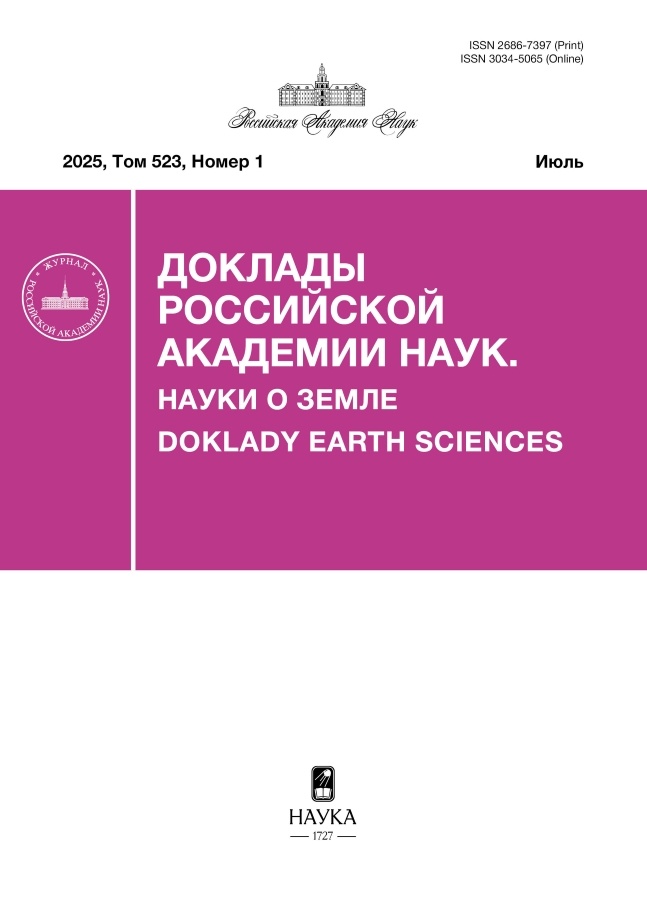Дальний атмосферный перенос пыли из Прикаспия в арктическую зону Европейской части России в декабре 2023 года
- Авторы: Губанова Д.П.1, Виноградова А.А.1,2, Котова Е.И.2
-
Учреждения:
- Институт физики атмосферы им. А.М. Обухова Российской Академии наук
- Институт океанологии им. П.П. Ширшова Российской Академии наук
- Выпуск: Том 519, № 2 (2024)
- Страницы: 133-140
- Раздел: ФИЗИКА АТМОСФЕРЫ И ГИДРОСФЕРЫ
- Статья получена: 04.06.2025
- Статья опубликована: 28.12.2024
- URL: https://jdigitaldiagnostics.com/2686-7397/article/view/682459
- DOI: https://doi.org/10.31857/S2686739724120171
- ID: 682459
Цитировать
Полный текст
Аннотация
Редкое явление – дальний атмосферный перенос пыли из аридных и семиаридных районов Прикаспия через центр Европейской части России в ее арктические регионы – зарегистрировано в декабре 2023 года в ходе натурных наблюдений за физико-химическими характеристиками аэрозольных частиц в Москве и за составом снежного покрова в Архангельской области. Анализ траекторий движения воздушных масс, динамики пространственно-временной изменчивости массовой концентрации аэрозолей РМ2.5 и РМ10 в Московском регионе, а также численные оценки и пространственные распределения приземной концентрации и оптических характеристик аэрозоля в Европейской части России (по данным реанализа MERRA-2) подтверждают повышение аэрозольного загрязнения воздуха на территориях от Прикаспия до Архангельской области. В пробе снега, отобранной в Государственном природном заповеднике “Пинежский” (Архангельской обл.) весной 2024 года, в толще снежного покрова на высоте 18–20 см (при общей высоте снежной толщи 65 см) обнаружен слой выпавшего в декабре 2023 года снега, имеющий желтоватую окраску. Предварительные исследования пробы этого снега показали присутствие большого количества органической взвеси и остатков растений, что зимой указывает на атмосферный перенос аэрозоля из южных регионов России.
Полный текст
Об авторах
Д. П. Губанова
Институт физики атмосферы им. А.М. Обухова Российской Академии наук
Автор, ответственный за переписку.
Email: gubanova@ifaran.ru
Россия, Москва
А. А. Виноградова
Институт физики атмосферы им. А.М. Обухова Российской Академии наук; Институт океанологии им. П.П. Ширшова Российской Академии наук
Email: gubanova@ifaran.ru
Россия, Москва; Москва
Е. И. Котова
Институт океанологии им. П.П. Ширшова Российской Академии наук
Email: gubanova@ifaran.ru
Россия, Москва
Список литературы
- Kok J. F., Storelvmo T., Karydis V. A. et al. Mineral dust aerosol impacts on global climate and climate change // Nat. Rev. Earth Environ. 2023. V. 4. P. 71–86. https://doi.org/10.1038/s43017-022-00379-5
- Klingmüller K., Lelieveld J., Karydis V.A., Stenchikov G.L. Direct radiative effect of dust–pollution interactions // Atmos. Chem. Phys. 2019. V. 19. P. 7397–7408. https://doi.org/10.5194/acp-19-7397-2019
- Schepanski K. Transport of mineral dust and its impact on climate // Geosciences. 2018. V. 8. 151. https://doi.org/10.3390/geosciences8050151
- Mahowald N. M., Kloster S., Engelstaedter S. et al. Observed 20th century desert dust variability: impact on climate and biogeochemistry // Atmos. Chem. Phys. 2010. V. 10. P. 10875–10893. https://doi.org/10.5194/acp-10-10875-2010
- Zhang X., Zhao L., Tong D. Q. et al. Systematic review of global desert dust and associated human health effects // Atmosphere. 2016. V. 7. 158. https://doi.org/10.3390/atmos7120158
- Gliss J., Mortier A., Schulz M. et al. AeroCom phase III multi-model evaluation of the aerosol life cycle and optical properties using ground- and space-based remote sensing as well as surface in situ observations // Atmos. Chem. Phys. 2021. V. 21. P. 87–128. https://doi.org/10.5194/acp-21-87-2021
- Ginoux P., Prospero J. M., Gil T. E. et al. Global-scale attribution of anthropogenic and natural dust sources and their emission rates based on MODIS Deep Blue aerosol products // Rev. Geophys. 2012. V. 50. RG3005. https://doi.org/10.1029/2012RG000388
- Gubanova D., Chkhetiani O., Vinogradova A. et al. Atmospheric transport of dust aerosol from arid zones to the Moscow region during fall 2020 // AIMS Geosciences. 2022. V. 8. № 2. P. 277–302. https://doi.org/10.3934/geosci.2022017
- van der Doe M., Knippertz P., Zschenderlein P. et al. The mysterious long-range transport of giant mineral dust particles // Science Advances. 2018. V. 4. Iss. 12. https://doi.org/10.1126/sciadv.aau2768
- Сельскохозяйственный словарь-справочник / Гл. ред. А. И. Гайстер. М.–Л.: Государственное издательство колхозной и совхозной литературы “Сельхозгиз”, 1934. 1280 с.
- Banks J. R., Heinold B., Schepanski K. Radiative cooling and atmospheric perturbation effects of dust aerosol from the Aralkum Desert in Central Asia // EGUsphere [preprint]. 2023. https://doi.org/10.5194/egusphere-2023-2772
- Shukurov K. A., Simonenkov D. V., Nevzorov A. V. et al. CALIOP-based evaluation of dust emissions and long-range transport of the dust from the Aral–Caspian arid region by 3D-source potential impact (3D-SPI) method // Remote Sens. 2023. V. 15. 2819. https://doi.org/10.3390/rs15112819
- Виноградова А. А., Губанова Д. П., Лезина Е. А., Иванова Ю. А. Пылевой аэрозоль из районов Северного Прикаспия в приземном воздухе центра европейской России // Оптика атмосферы и океана. 2024. Т. 37. № 6. С. 453–460. https://doi.org/10/10.15372/AOO20240602.
- Губанова Д. П., Виноградова А. А., Лезина Е. А. и др. Условно-фоновый уровень аэрозольного загрязнения приземного воздуха в Москве и пригороде: сезонные вариации // Изв. РАН. Физика атмосферы и океана. 2023. Т. 59. № 6. С. 754–773. https://doi.org/10.31857/S0002351523060056
- Seinfeld J. H., Pandis S. N. Atmospheric chemistry and physics: from air pollution to climate change, 2nd Еdition. New York: Wiley, USA, 2006. 1232 p.
- Stein A. F., Draxler R. R, Rolph G. D. et al. NOAA’s HYSPLIT atmospheric transport and dispersion modeling system // Bull. Amer. Meteor. Soc. 2015. V. 96. P. 2059–2077. https://doi.org/10.1175/BAMS-D-14-00110.1
- Gelaro R., McCarty W., Suárez M. J. et al. The modern-era retrospective analysis for research and applications, version 2 (MERRA-2) // J Clim. 2017. V. 30. Iss. 13. P. 5419–5454. https://doi.org/10.1175/JCLI-D-16-0758.1
- Одинцов С. Л., Гладких В. А., Камардин А. П., Невзорова И. В. Высота слоя перемешивания в условиях температурных инверсий: экспериментальные данные и модельные оценки // Оптика атмосферы и океана. 2022. Т. 35. № 7. С. 549–558. https://doi.org/10.15372/AOO20220705
- Шукуров К. А., Шукурова Л. М. Регионы-источники нитрата аммония, сульфата аммония и природных силикатов в приземном аэрозоле Западного Подмосковья // Изв. РАН. Физика атмосферы и океана. 2017. Т. 53. № 3. С. 360–369. https://doi.org/10.7868/s0002351517030142
- Шевченко В. П., Коробов В. Б., Лисицын А. П. и др. Первые данные о составе пыли, окрасившей снег на европейском севере России в желтый цвет (март 2008 г.) // ДАН. 2010. Т. 431. № 5. С. 675–679.
Дополнительные файлы

















